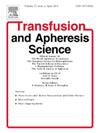身体质量指数会影响健康供体的干细胞产量吗?
IF 1.2
4区 医学
Q4 HEMATOLOGY
引用次数: 0
摘要
目的造血干细胞移植是治疗多种良恶性疾病的重要手段。已经研究了影响供体动员反应从而影响造血祖细胞产量的因素,但对供体体重指数的研究有限且相互矛盾。我们研究的目的是调查这种情况。材料与方法对665例健康献血者的资料进行分析,将体重指数(BMI)≥ 25(第1组,n: 247)和≥ 25 kg/m2(第2组,n: 418)分为2组。除人口统计学资料外,评估吸烟情况、血型、动员所用药物、采血天数、处理血量、采集量、动员前全血计数及生化指标。结果1组247例,2组418例。1组中位年龄为29(18-66)岁,2组中位年龄为37(18-68)岁。中位BMI分别为22.49(16.10-24.98)和28.06 (25.00-48.27)kg/m²。1组男性供体占62.7 %,2组男性供体占73.9 %。第2组的单采天数较低,第1天和总CD34+干细胞计数中位数均高于对照组(分别为7.1 ×106/kg和7.58 ×106/kg)。结论健康献血者CD34+干细胞与BMI存在相关性,各组间吸烟习惯、血型、粒细胞刺激剂类型、处理血容量、非淋巴细胞及除LDH外的生化指标差异无统计学意义。本文章由计算机程序翻译,如有差异,请以英文原文为准。
Does body mass index affect stem cell yield in healthy donors?
Objectives
Hematopoietic stem cell transplantation is an important treatment for many benign and malignant diseases. Factors affecting the donor response to mobilization and thus hematopoietic progenitor cell yield have been investigated, but studies on donor body mass index are limited and contradictory. Our aim in our study was to investigate this situation.
Material and methods
The data of a total of 665 healthy donors were analyzed and divided into 2 groups as body mass index (BMI) < 25 (group 1, n: 247) and ≥ 25 kg/m2 (group 2, n: 418). In addition to demographic data, smoking, blood group, agent used for mobilization, number of days of apheresis, volume of blood processed, amount of product collected, complete blood count before mobilization and biochemical parameters were evaluated.
Results
Group 1 consisted of 247 and group 2 consisted of 418 participants. Median age was 29 (18–66) years in group 1 and 37 (18–68) years in group 2. Median BMI was 22.49 (16.10–24.98) and 28.06 (25.00–48.27) kg/m², respectively. Male donors constituted 62.7 % in group 1 and 73.9 % in group 2. In group 2, the number of apheresis days was lower and the median CD34+ stem cell count on the first day and in total was statistically significantly higher (7.1 ×106/kg and 7.58 ×106/kg, respectively).
Conclusion
In healthy donors, CD34+ stem cells were correlated with BMI, whereas no statistically significant difference was found between the groups in terms of smoking habit, blood group, granulocyte stimulating agent type, processed blood volume, non-lymphocyte and biochemical parameters other than LDH.
求助全文
通过发布文献求助,成功后即可免费获取论文全文。
去求助
来源期刊
CiteScore
3.60
自引率
5.30%
发文量
181
审稿时长
42 days
期刊介绍:
Transfusion and Apheresis Science brings comprehensive and up-to-date information to physicians and health care professionals involved in the rapidly changing fields of transfusion medicine, hemostasis and apheresis. The journal presents original articles relating to scientific and clinical studies in the areas of immunohematology, transfusion practice, bleeding and thrombotic disorders and both therapeutic and donor apheresis including hematopoietic stem cells. Topics covered include the collection and processing of blood, compatibility testing and guidelines for the use of blood products, as well as screening for and transmission of blood-borne diseases. All areas of apheresis - therapeutic and collection - are also addressed. We would like to specifically encourage allied health professionals in this area to submit manuscripts that relate to improved patient and donor care, technical aspects and educational issues.
Transfusion and Apheresis Science features a "Theme" section which includes, in each issue, a group of papers designed to review a specific topic of current importance in transfusion and hemostasis for the discussion of topical issues specific to apheresis and focuses on the operators'' viewpoint. Another section is "What''s Happening" which provides informal reporting of activities in the field. In addition, brief case reports and Letters to the Editor, as well as reviews of meetings and events of general interest, and a listing of recent patents make the journal a complete source of information for practitioners of transfusion, hemostasis and apheresis science. Immediate dissemination of important information is ensured by the commitment of Transfusion and Apheresis Science to rapid publication of both symposia and submitted papers.

 求助内容:
求助内容: 应助结果提醒方式:
应助结果提醒方式:


